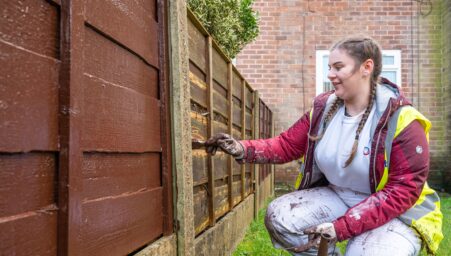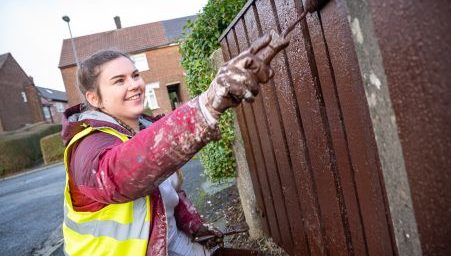Painting and Decorating
Overview
Painting and Decorating involves transforming spaces, making it a hands-on and creative job that brings variety and job satisfaction. Whether you’re interested in residential, commercial, or industrial projects, there is growing demand in the UK. This career is accessible to everyone, regardless of age or background.
More about Painting and Decorating
What do Painters and Decorators do?
As a Painter and Decorator, you will take on a range of tasks. Your duties will vary depending on the project, but some common responsibilities include:
- Preparing surfaces by removing old paint or wallpaper, filling holes, and sealing cracks
- Calculating materials and mixing paint to the correct shade
- Covering surfaces with primer and undercoat
- Applying paint or hanging wallpaper
- Adding special finishes such as stains, varnishes or marbling
- Protecting areas with dust sheets and tidying up after each project
You’ll use various tools such as brushes, rollers, and spray equipment to create a high-quality finish.
What skills will you use?
To be successful in painting and decorating, you’ll need a mix of practical and personal skills. Attention to detail is essential to ensure high-quality work, while physical stamina is necessary as much of the job requires working with your hands and being comfortable on ladders or scaffolding.
Strong communication skills are important for working with clients, and problem-solving skills will help you adapt to challenges on the job.
If you choose to work for yourself, business and time management skills will be vital to manage your projects effectively.
Where can this job take you?
The Painting and Decorating industry offers a variety of opportunities for career growth.
As you gain experience, you could move into supervisory or management roles, specialise in areas such as heritage conservation or set design, or even start your own business.
Additionally, you could explore related fields such as estimating, contract management or interior design.
How to become a Painter & Decorator?
Whether you’re just finishing school or are considering a career change, there are several routes to get started:
- College Courses: A Level 2 or Level 3 Diploma in Painting and Decorating will equip you with the skills you need to land a trainee position.
- Apprenticeships: Apprenticeships are a great way to learn while you work. You’ll gain hands-on experience, earn a wage, and receive training from a college or provider.
- Entry-Level Roles: Starting as a Painter and Decorator’s labourer will give you practical experience and the opportunity to pursue further training.
What qualifications do you need?
While many employers value enthusiasm and a willingness to learn, the typical qualifications you may need include:

College Courses
For a Level 2 course, you will generally need 2 GCSEs at grades 9-3 (A*-D), or for a Level 3 course, 4-5 GCSEs at grades 9-4 (A*-C) or equivalent.

Apprenticeships
For a Level 2 apprenticeship, some GCSEs (usually including English and maths) may be required. For an advanced apprenticeship, you might need 5 GCSEs at grades 9–4 (A*–C) or equivalent. However, not all employers require formal qualifications.

Construction Skills Certification Scheme
You’ll also need a CSCS (Construction Skills Certification Scheme) card to work on a construction site.
Organisations
Joining professional organisations can help you with ongoing development, access to training resources, and industry news. Consider joining the Painting and Decorating Association.
WaMT are dedicated to supporting women who are interested in pursuing a trade. Please contact us on support@procure-plus.com if you have any questions.
All other Trades
Joinery
Roofing
Electrical
Plumbing
Bricklaying
Want to meet other Tradeswomen?
Whether you’re considering a career change, just getting started, or already working in the trade, our dedicated Facebook groups are a place to share advice, ask questions, and chat with other women who get it.